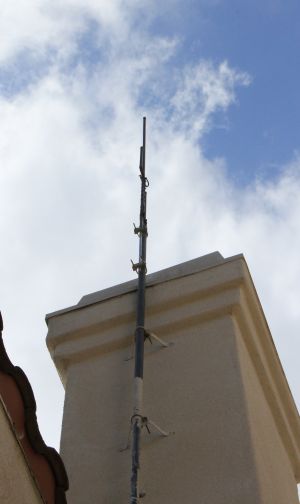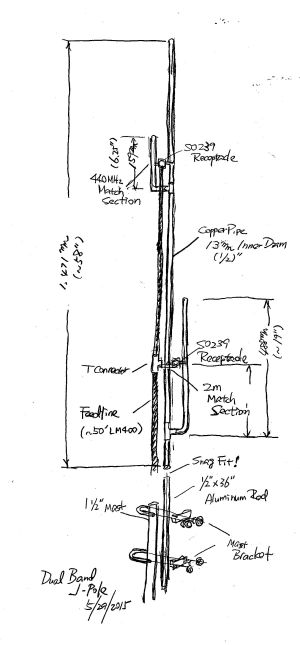W6SI Blog Page (Entry 6)
6/1/2015
Raising a Copper Pipe J-Pole Antenna
There is nothing novel or unique about a J-Pole antenna. But after a minor emergency here at W6SI, I had to lift my lazy buns to raise a new V/UHF antenna. This is a practical talk about that experience, and it would be great if any of this helps someone doing something similar.
Recently, my faithful V/UHF booster amplifier of the past 10+ years died, and since I was using it with my HT to reach my local repeaters from home, I thought I was into an unscheduled major expense…
For V/UHF communication, I have been using a discone antenna that I picked up at a junk store long time ago. It was mounted on a chimney of the house. It had a very broad bandwidth, but I never knew how well it is radiating. I was thinking about replacing that antenna for some time, if just for trying out something different. Then I dug out from the deep corner of my garage, a copper tube J-pole antenna. Why not try that, see if it can work better to compensate for the loss of transmission power.
The antenna was picked up (again) a long time ago at a swap meet (I remember spending $20 for it), and except for a few occasion on portable set ups, I have not been using it. I don’t remember from whom I bought it, and whether anything similar is still available. By that, I mean the antenna is of relatively rare shape, having two match sections, presumably for 2m and 440. So it might be more appropriate to call it “J-J-Pole”. Generally people build it for a 2m then use it for 440 as “almost” 3rd harmonic tune. So it is not every day to see a J-pole with two independent match sections. In fact, if you Google J-pole, you are not likely to find one like this.
I first tested it on the ground level, mounted on a tripod, just to see if it works at all. It did resonate at about 146MHz, but impedance was not quite right, exhibiting SWR of 1.7 to 2. The match appear to be somewhat better at 440, but I did not have enough power on my HT to drive my SWR meter to a full range. It hit the repeater at 1 Watt, though it was not quite full-quieting. It’ll work better at the top of the chimney, where it can see the Santiago Peak directly.
Then came a problem. The base of the antenna, the part below the 2m match section, was not long enough to support the antenna. Since it is entirely made of copper pipe, the top heavy antenna needs a solid attachment to the mast to be safely supported. Then I realized a simple fact. When you say ½” pipe, it means the inner diameter. And it actually slightly larger than ½”. I measured (with my metric caliper) 13.5mm. Almost 1mm thicker than ½”. Then I went to the Home Depot and found ½” aluminum rod. The Rod is (obviously) measured with outer diameter. In short, the ½” rod is a snug fit to ½” copper pipe. I bought a 36” rod and tried it on the J-pole. A perfect fit. I wrapped a layer of rubber tape at the middle of the rod, so it won’t go any deeper inside the antenna beyond that.
Then an alert reader might ask, “Doesn’t that change the electrical length of the antenna?” Read on.
Now it’s time to climb the ladder to the top of chimney. I cut the story short. It was a little struggle to dismount the discone antenna. I thought it was just sitting on the top of the mast, but it refused to come off. Since I was in a pretty precarious position at the top of the ladder, I had to change the plan and dismount the steel mast altogether to remove the old and mount the new antenna.
As it turned out (and I should have known) the discone was attached to the mast with a pair of fit screw, and I needed a hex wrench to remove it. Once the right size was found, things started to go smoothly.
I had a stock of a pair of U-bolt assemblies with mast brackets (purchased from SolidSignal.com) to attach the J-pole to the top of the mast, and raised the mast back on the chimney, utilizing the existing wall mount. At that point, the SWR reading of the antenna was pretty much the same as the one I measured on the ground (1.7 ~ 2). Not great, but usable. So while on the ladder, I used my HT to see if I can make a contact via the repeater with a low power (1Watt). I did. And it sounded like full quieting. For my application, the J-pole antenna is clearly outperforming the incumbent discone.
One of the debates I hear often about J-pole, copper pipe versions specifically, is whether it is necessary to ground its base, or should be insulated from ground. I hear both arguments, but without much theoretical substantiation. This mounting of mine, is not grounded. The antenna is attached to a 32mm (1 ¼”) steel mast, un-insulated. The mast is attached to the chimney (stucco – non-conductive) with a pair of wall mounts. Feed point is about 25’ above ground. Prior to taking it up there, I ran some experiments by mounting it on a tripod in the backyard with or without grounding wire attached. It really made no difference. Grounded or not, the J-Pole worked just fine, with no significant change in SWR. I don’t have a definitive explanation for this (yet). Besides, you can’t “RF-ground” the antenna when it’s up there. The grounding wire will be much longer than 2m wave length. It does make sense as a DC ground, to avoid lighting hit. But you can do the same by inserting a lightning arrestor in the feed line. I have not tried to attach radials at the base (for creating an RF ground plane), but my attitude is, “why bother”?
One mystery still remains. Why is the SWR higher for this antenna? Similar sized J-pole are reported to have a low SWR (like near 1.0) with a good bandwidth to cover the entire 2m band. Mine does seem to be stable over fairly broad range of frequency too, but the impedance is a little low at the resonance. I am thinking that because there are two independent match sections, the two impedances are added in parallel, making the composite impedance lower. It is not clear why the builder of the antenna put two match sections. It should have worked fine with just 2m section.
But OK, it works. I get full quieting to all repeaters I access from home, using just an HT. I don’t have to invest on a new power booster amp for a while.
One last word. The gain of the antenna. There is no theoretical “gain” per se for either discone or J-pole, compared to dipole (if anyone is using dipole for 2meter). In fact, the concept of gain does not apply to mostly omni-directional antenna. But in practice, different types of omni antenna work differently, to their own merit. So let’s not say that “this antenna has gain over that antenna”, the location, height, surroundings, surrounding ground characteristics etc., can affect more than just the shape of an antenna. I am NOT saying J-pole always works better than discone. Only definitive way to know the antenna performance is to experiment with it.
Above is a reflection of my thought and only mine. But if you have any questions, feedback and/or suggestions, please send me an e-mail. I might reply on this page (sorry, no guarantee)

